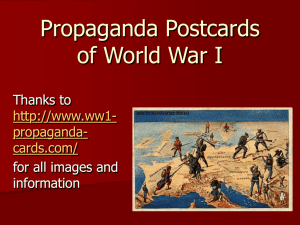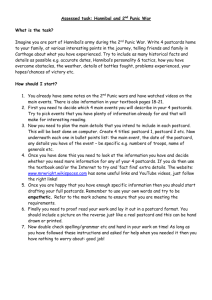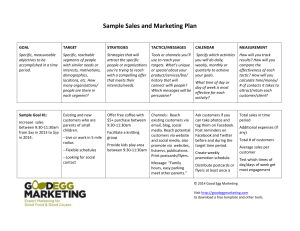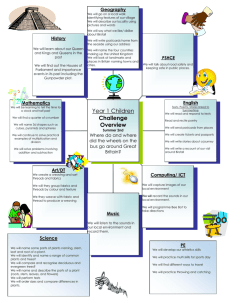Lesson Plan
advertisement
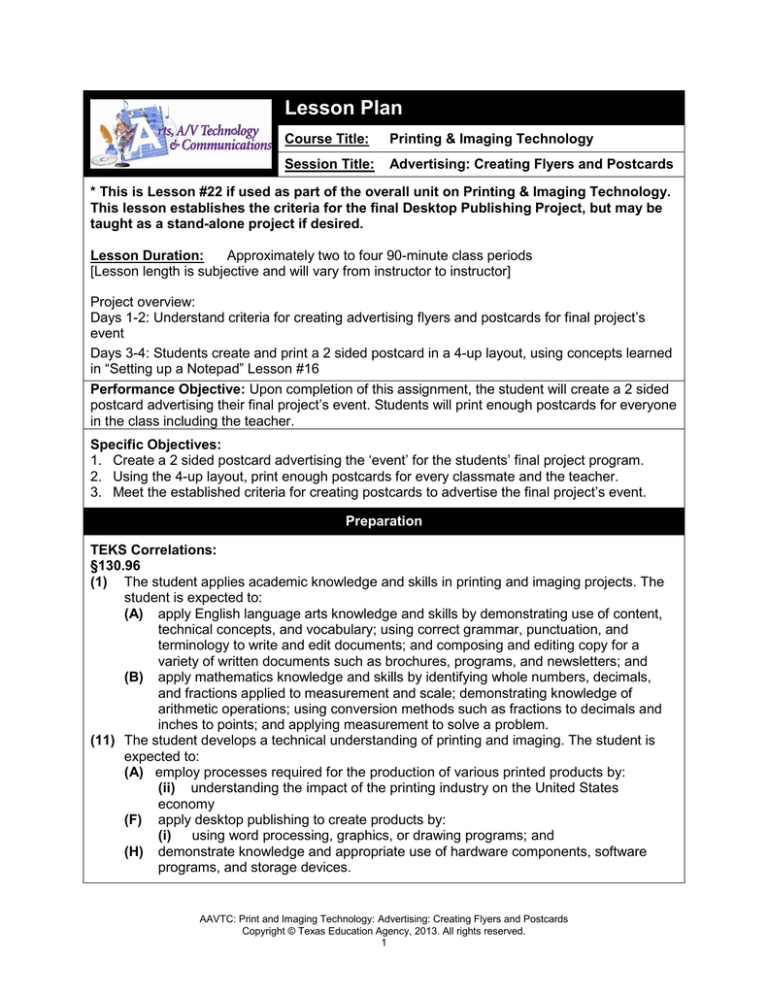
pe Lesson Plan Course Title: Printing & Imaging Technology Session Title: Advertising: Creating Flyers and Postcards * This is Lesson #22 if used as part of the overall unit on Printing & Imaging Technology. This lesson establishes the criteria for the final Desktop Publishing Project, but may be taught as a stand-alone project if desired. Lesson Duration: Approximately two to four 90-minute class periods [Lesson length is subjective and will vary from instructor to instructor] Project overview: Days 1-2: Understand criteria for creating advertising flyers and postcards for final project’s event Days 3-4: Students create and print a 2 sided postcard in a 4-up layout, using concepts learned in “Setting up a Notepad” Lesson #16 Performance Objective: Upon completion of this assignment, the student will create a 2 sided postcard advertising their final project’s event. Students will print enough postcards for everyone in the class including the teacher. Specific Objectives: 1. Create a 2 sided postcard advertising the ‘event’ for the students’ final project program. 2. Using the 4-up layout, print enough postcards for every classmate and the teacher. 3. Meet the established criteria for creating postcards to advertise the final project’s event. Preparation TEKS Correlations: §130.96 (1) The student applies academic knowledge and skills in printing and imaging projects. The student is expected to: (A) apply English language arts knowledge and skills by demonstrating use of content, technical concepts, and vocabulary; using correct grammar, punctuation, and terminology to write and edit documents; and composing and editing copy for a variety of written documents such as brochures, programs, and newsletters; and (B) apply mathematics knowledge and skills by identifying whole numbers, decimals, and fractions applied to measurement and scale; demonstrating knowledge of arithmetic operations; using conversion methods such as fractions to decimals and inches to points; and applying measurement to solve a problem. (11) The student develops a technical understanding of printing and imaging. The student is expected to: (A) employ processes required for the production of various printed products by: (ii) understanding the impact of the printing industry on the United States economy (F) apply desktop publishing to create products by: (i) using word processing, graphics, or drawing programs; and (H) demonstrate knowledge and appropriate use of hardware components, software programs, and storage devices. AAVTC: Print and Imaging Technology: Advertising: Creating Flyers and Postcards Copyright © Texas Education Agency, 2013. All rights reserved. 1 Instructor/Trainer References: Industry standard software: Help menu or Tutorial Author’s expertise Instructional Aids: Advertising the Event slide presentation Flyers and Postcards Rubric Materials Needed: Industry standard desktop publishing software Examples of advertising flyers, brochures, postcards, etc. Equipment Needed: Computer and projection system with appropriate software to display slide presentation Classroom set of computers with Industry standard desktop publishing software Learner Recommended: Completion of previous lessons in the project sequence. Introduction MI Introduction (LSI Quadrant I): ASK: Now that you have created a program, how do you get people to come to your event? (let the students give ideas before starting the slide presentation) SAY: You need to advertise your event. One way to advertise is to create an ‘Event Flyer’. Outline MI Outline (LSI Quadrant II): Instructor Notes: I. ‘Event Flyers’ come in many shapes, sizes and styles: A. Postcards B. Brochures C. Pamphlets D. Posters Note: Use the slide presentation to go over each point to help students understand the different kinds of ‘Event Flyers’ and the criteria for creating one to advertise their event. II. Some ‘Event Flyers’ only have information on one side: A. Pamphlets B. Posters Ask the students to name or describe different ‘Event Flyers’ that they have seen. Was there information on both sides? (Show examples if you have them.) III. Other ‘Event Flyers’ have information on both sides: A. Postcards B. Brochures Regarding 2 sided ‘event flyers’, ask students if they ever opened up a brochure to AAVTC: Print and Imaging Technology: Advertising: Creating Flyers and Postcards Copyright © Texas Education Agency, 2013. All rights reserved. 2 IV. Criteria for Creating Postcards: A. Postcards should be 2 sided; 4” x 5” B. Use logo and imagery from the event program’s front cover C. Date and Location should be on the front D. Choose information to put on the back (for example) a. Schedule of Events b. Map of the Venue c. Sponsor List E. Add an event description to get people to come to the event F. Using the 4-up layout from the “Setting up the Notepad” Lesson #16, print enough postcards for every classmate and the teacher read what was inside. Why or why not? Along the same lines, did they turn the postcard over to see what was on the other side? Why or why not? Note: The criteria listed here are to help students see the scope of the work ahead. Information placed on the back of the postcard should be relevant to the event. The event description should be checked for spelling, just like the elements and text in the final program. The slide presentation shows the dimensions from the “Setting up the Notepad” Lesson #16. The students will need to determine how to print on both sides of the postcard so the information is not upside down on one side. This is affected by the way the paper is fed into the printer. Application MI Guided Practice (LSI Quadrant III): Help students understand some differences between single sided and double sided ‘Event Flyers’. Make sure students know the criteria for creating a postcard to advertise the event of their program. Discuss the dimensions of the postcards and how they should be printed using the 4-up concept developed in the “Setting up a Notepad” Lesson #16. Encourage students to be creative in creating a description of their event so it will draw attention. Make sure students know how many postcards to print. MI Independent Practice (LSI Quadrant III): AAVTC: Print and Imaging Technology: Advertising: Creating Flyers and Postcards Copyright © Texas Education Agency, 2013. All rights reserved. 3 Students will use the logo and imagery from their programs to create a two-sided postcard that is 4” x 5”. They will also add an event description to their postcards. Students will use industry standard desktop publishing software to complete the postcard design. They will use the 4-up layout directions from Lesson #16 and print enough copies for every classmate and the teacher to have a copy. Summary MI Review (LSI Quadrants I and IV): Review the criteria for creating a postcard to advertise an event. Review the dimensions for advertising postcards and how to print both sides of a 4up layout. Observe students’ progress, ask questions, and encourage creativity as they lay out the design for a postcard that will advertise their event. Evaluation MI Informal Assessment (LSI Quadrant III): Teacher will monitor the students’ progress while they use the desktop publishing software to create and lay out all of the elements for their postcards. The teacher will: … make sure students understand the criteria for creating the postcards. … make sure students know how to print on both sides of the 4-up layout. MI Formal Assessment (LSI Quadrant III, IV): The teacher will use the Flyers and Postcards Rubric to evaluate the postcards submitted by the students. The teacher should also conference with each student to provide one-on-one feedback of the student’s work. Extension MI Extension/Enrichment (LSI Quadrant IV): Students may wish to get their postcards laminated for a higher quality look and feel or …they may wish to create and print an event poster (at least 8.5” x 11”) using their logo, imagery, event date and location, and their new event description. AAVTC: Print and Imaging Technology: Advertising: Creating Flyers and Postcards Copyright © Texas Education Agency, 2013. All rights reserved. 4 FLYERS AND POSTCARDS RUBRIC Criteria Completeness (10 points) Application of Layout Concepts (30 points) Design elements – Criteria (30 points) Creativity (20 points) Professional Appearance (10 points) Comments: Exceptional Above Average Below Average Unacceptable 9-10 points 5-8 points 1-4 points 0 points Work is complete and presents a unified whole. Work is complete, but lacks unity in the composite. Work is incomplete. No attempt was made to produce the document. 25-30 points 12-24 points 1-11 points 0 points Demonstrated knowledge of Creating Postcards Concepts is exceptional. Creating Postcards Concepts are used, but more practice is needed to demonstrate full knowledge. Attempt is made to use Creating Postcards Concepts, but it is evident that knowledge is very limited. No evidence of knowledge of Creating Postcards Concepts. 25-30 points 12-24 points 1-11 points 0 points Design elements are successfully applied. Design elements are applied but need refinement to achieve success. Design elements are poorly applied. No evidence of application of design elements. 17-20 points 8-16 points 1-7 points 0 points Design ideas are original in thought and exceptionally creative. Design ideas are somewhat original and creative. Limited evidence of creativity and originality in thought. No evidence of creativity or originality in thought or execution of project. 9-10 points 5-8 points 1-4 points 0 points Professional project. Final product is neat and professionally presented. Good presentation of project. Only minor corrections are needed Fair presentation of project. Several errors are evident. Project is unprofessional. Errors distract significantly from the content. TOTAL POINTS: AAVTC: Print and Imaging Technology: Advertising: Creating Flyers and Postcards Copyright © Texas Education Agency, 2013. All rights reserved. 5 Points
